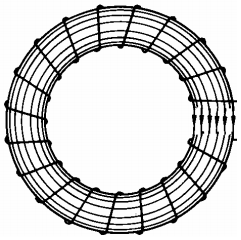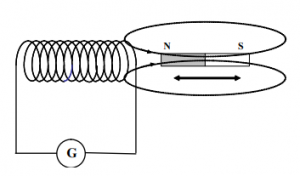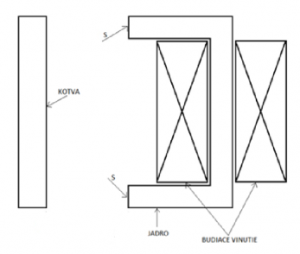An electromagnetic field is a physical field that corresponds to the degree of action of electromagnetic energy in space and consists of a magnetic field and an electric field that are interconnected. The electric current creates a magnetic field in the area of the charged body, which affects the movement of the bodies around the charged body. An electric voltage is induced in the conductor, which moves in the magnetic field, and so the conductor (current flows through it) can move in the magnetic field = with a certain force.
The electric field cannot be separated from the magnetic field because they are related and therefore we speak of an electromagnetic field.
Maxwell’s equations (published in 1873 by the theoretical physicist James Clerk Maxwell) are the basis for the description of the electromagnetic field. These laws are natural, they do not need to be derived from other laws, however other electromagnetic field equations can be derived from them.
Toroid magnetic field
A toroid is a coil whose same turns are wound on a ring and we can imagine it as a solenoid twisted into the shape of a ring. This is a special case of a coil without magnetic poles. Its induction lines run only inside the ring as concentric circles and the created magnetic field is almost homogeneous.

Img.1 Application of Ampere’s law for a toroid
Electromagnetism
Electric charge is the physical property of matter that causes it to experience a force when placed in an electromagnetic field. The electric charge (if we take it as a basic term for the description of electromagnetism) is so fundamental that we only can talk about its properties.
The basic properties of an electric charge include the following statements:
- there are two types of electric charge, positive (marked with a + sign) and negative (marked with a – sign),
- electric charges have a repulsive effect on each other (charges with the same sign are repelled) or attractive (charges with the opposite sign are attracted),
- the law of conservation of electric charge (meaning that the charge of the universe is constant),
- a fundamental charge is the magnitude of the charge on an electron which is e=1.6×10-19C
Electromagnetism, as a part of physics, that studies the connections between electrical and magnetic aspects, did not exist. Until the end of the 18th century, electrical and magnetic energy were studied separately, because no mutual effects were observed between the events. Various important mathematicians were involved in building the theory of electromagnetism, but it was not until James Clerk Maxwell developed the pioneering theory of electromagnetism and formulated the four laws of electromagnetism = Maxwell’s equations.
Electromagnetic induction
Michael Faraday (1791 – 1867) studied electromagnetism and from the knowledge of Hans Christian Oersted and Andre Marie Ampère, who proved that the presence of a magnetic field causes the flow of electric current (directed movement of an electric charge), logically assumed that this analogy also happens in the opposite direction and that the source of electric current may be a magnetic field. The reasoning was the basis of many experiments.

Img. 2 Induction of induced electric current
Electromagnetic induction is a phenomenon in which an induced electromotive voltage and an induced current occur in a conductor due to a change in the time of magnetic induction flux.
The change in magnetic flux induction can occur:
- by changing the magnetic induction,
- by changing the capacity of the surface,
- by changing the angle between the surface normal and the induction lines.
Electromagnet
An electromagnet is a type of magnet that converts electrical energy into work = mechanical energy, it exerts a certain force. It is a part of all switching, protection and protection devices. When it comes to frequent switching and small strokes, it is the electromagnet that is suitable for operating these switching machines.
Uses for Electromagnets
The usage of an electromagnet is mainly for the development of smaller forces (it is related to the expansion in contactors) but also for applications in industry or electrical machines. The stroke time of the armature of the electromagnet is small, therefore the size of the work performed is also small. It is not the amount of energy that is significant but its tensile force, which acts during the stroke time.
Static tensile characteristic is the dependence of the tensile force on the stroke of the armature, which expresses the properties of DC or AC electromagnets. Armature tightening time is also an important parameter. When the electromagnet is supplied with direct current, the current does not change in the steady-state, nor the voltage of the coil and one electrical parameter of the excitation winding always stays constant. From the shape of the electromagnets, the size of the air gap and the type of supply = the shape of the static tensile characteristic.
Types of electromagnets
Electromagnets can be divided into:
According to the current:
- DC electromagnets
- electromagnets for alternating one-way current,
- three-phase alternating current electromagnets.
According to the usage
- motion electromagnets – mechanical force is performed by the movement of the armature (switching devices, brakes, valves…),
- holding electromagnets – hold ferromagnetic material (clamping, sorting cylindrical, load…),
- special electromagnets (electromagnetic couplings…).
Principle of operation of electromagnets
The electric current, which is the source of the magnetic field, passes through the excitation coil, where it creates a magnetic voltage that pushes the magnetic flux through the magnetic circuit = a magnetic field with a certain magnetic intensity and a certain magnetic flux is created.
The magnetic flux is directly proportional to the flowing current, which means that the greater the current or the greater the number of turns of the excitation coil, the stronger the magnetic field. A magnetic field acts on the armature of the electromagnet and uses a certain tensile force acting on the armature (ferromagnetic material). If the current of the magnetic field is interrupted and the force is generated, the armature falls to its original position.
Construction of electromagnets
The electromagnet has a simple construction, which consists of an excitation coil, a movable armature and a fixed ferromagnetic core.

Img. 3 Solenoid components, construction of electromagnets
Excitation coil – can have single-layer or multi-layer windings. The number and shape of the air gaps depends on the shape of the magnetic circuit and the coil. The armature located inside the coil may be attracted to the bearing surface or the electromagnet may attract it to the excitation coil. The magnetic circuit is implemented with regard to the economy of operation at acceptable dimensions and weight so that mostly (or completely) the magnetic flux passes through the ferromagnet, which has a very high magnetic conductivity. The individual types of electromagnets (trying to keep the air flow only in the working gap of the electromagnet) have different static tensile characteristics, on the basis of which the correct type of electromagnet for a given application is then selected.
The core and the armature are mostly formed in one-way electromagnets – gaseous ferromagnetic material, in the case of alternating electromagnets – insulated transformer sheets made of ferromagnet (due to the reduction of eddy current losses during alternating magnetization). Cast iron and steel (magnetically hard materials) are not recommended, due to their residual magnetism, which persists even after a power failure.
The work of the electromagnet is affected by swirl currents, which reduce the speed of its application.
Unidirectional electromagnets
The unidirectional electromagnet (DC) consists of a magnetic circuit made of ferromagnetic material (although they have a high conductivity and allow the creation of a strong magnetic field, the transmittance depends on the magnetic induction), a motion armature and an excitation coil which is supplied with direct current.
The core of a DC electromagnet is usually made of solid material.
Benefits of one-way electromagnet:
- simple construction,
- quiet operation,
- in terms of current ratios and their effects on force ratios, dimensions and use of the magnetic circuit,
- the anchor does not have to be in the end position,
- the switching density is limited only by the speed of the pull-in and drop-out of the armature.
Disadvantages of one-way electromagnet
- slower pull,
- dropping of the armature,
- lower tensile force compared to AC electromagnets,
- continuous (maximum) current during the whole application time.
Alternating electromagnets
The excitation coil of the alternating-current electromagnets (AC) is powered by an AC power source. The current is determined by the resistance and the inductance of the coil itself, the inductance depends on the position of the armature.
The switching density is limited by the density of the pull-in and drop-out of the armature and also by the maximum permitted heating. Their force ratios also depend on the degree of saturation of the core.
Benefits of alternating-current electromagnet
- faster armature tension.
Disadvantages of alternating-current electromagnet
- magnetic circuit, which consists of electrical sheets,
- the armature must be placed in the end position to prevent vibrations,
- humming, due to the vibration of the sheets,
- when the armature is tightened, shocks occur due to the fact that the tightened current is greater than the rated current.
References:
- Adamovic Andrej, Bc., Analýza a optimalizácia vlastností elektromagnetu, Žilinská univerzita v Žiline, Elektrotechnická fakulta
- Varga Radovan, Bc., Prípravok pre demonštrovanie účinkov elektromagnetickej indukcie, Technická univerzita v Košiciach, Fakulta elektrotechniky a informatiky
- https://sk.wikipedia.org/wiki/Elektromagnetick%C3%A1_indukcia
- https://sk.wikipedia.org/wiki/Elektromagnet
- https://moodle.uiam.sk/pluginfile.php/7056/mod_resource/content/0/Kapitola_6/Kap6fA4str85-101.pdf
- http://domes.spssbrno.cz/web/DUMy/ELE/VY_32_INOVACE_44-14.pdf
- https://moodle.uiam.sk/pluginfile.php/7063/mod_resource/content/0/Kapitola_7/Kap7fA4str102-109.pdf

